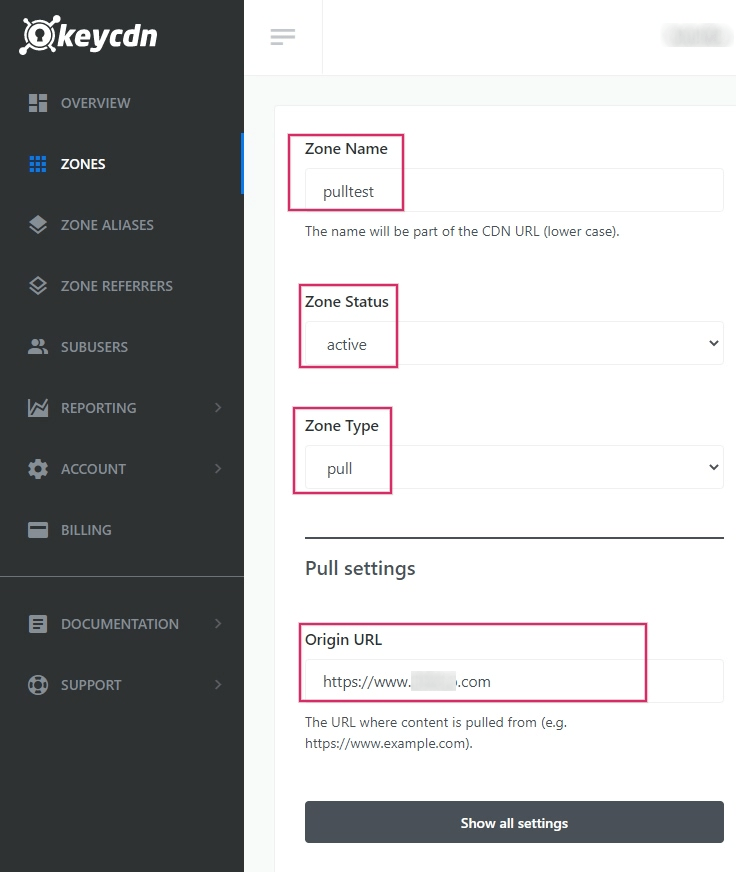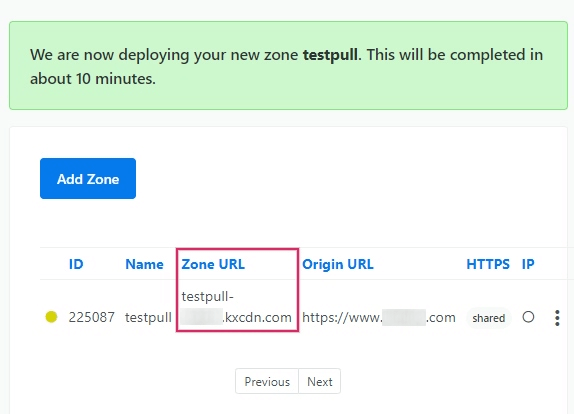Set up a content delivery network (CDN)
Deploying with KeyCDN
A CDN (Content Delivery Network) or content distribution network, is a geographically distributed network of servers that provides high speed internet content. The CDN (Content Delivery Network) provides quick, high-quality content delivery for content-heavy websites.
This document will guide you through the setup of a KeyCDN account with a Varyshop powered website.
Create a pull zone in the KeyCDN dashboard
On the KeyCDN dashboard, start by navigating to the Zones menu item on the left. On the form, give a value to the "Zone Name", which will appear as part of the CDN (Content Delivery Network)'s URL (Uniform Resource Locator). Then, set the "Zone Status" to "active" to engage the zone. For the "Zone Type" set the value to "Pull", and then, finally, under the "Pull Settings", enter the "Origin URL"— this address should be the full Varyshop database URL (Uniform Resource Locator).
Example: Use
https://yourdatabase.varyshop.comand replace the yourdatabase subdomain prefix with the actual name of the database. A custom URL (Uniform Resource Locator) can be used, as well, in place of the Varyshop subdomain that was provided to the database.

Under the "General Settings" heading below the zone form, click the "Show all settings" button to expand the zone options. This should be the last option on the page. After expanding the "General Settings" ensure that the "CORS" option is "enabled".
Next, scroll to the bottom of the zone configuration page and "Save" the changes. KeyCDN will indicate that the new zone will be deployed. This can take about 10 minutes.

Note: A new "Zone URL" has been generated for your Zone, in this example it is
pulltest-xxxxx.kxcdn.com. This value will differ for each database.
Copy this "Zone URL" to a text editor for later, as it will be used in the next steps.
Configure the Varyshop instance with the new zone
In the Varyshop "Website" app, go to the Settings and then activate the "Content Delivery Network (CDN)" setting and copy/paste the "Zone URL" value from the earlier step into the "CDN Base URL" field. This field is only visible and configurable when the developer mode is activated.
Note: Ensure that there are two forward slashes (
//) before the "CDN Base URL" and one forward slash (/) after the "CDN Base URL".
"Save" the settings when complete.

Now the website is using the CDN for the resources matching the "CDN filters" regular expressions.
In the HTML of the Varyshop website, the CDN (content delivery network) integration is evidenced as working properly by checking the URL (Uniform Resource Locators) of images. The CDN Base URL value can be seen by using your web browser's "Inspect" feature on the Varyshop website. Look for it's record by searching within the "Network" tab inside of devtools.

Prevent security issues by activating cross-origin resource sharing (CORS)
A security restriction in some browsers (such as Mozilla Firefox and Google Chrome) prevents a remotely linked CSS file to fetch relative resources on this same external server.
If the CORS (Cross-Origin Resource Sharing) option isn't enabled in the "CDN Zone", the more obvious resulting problem on a standard Varyshop website will be the lack of Font Awesome icons because the font file declared in the Font Awesome CSS won't be loaded from the remote server.
When these cross-origin resource issues occur, a security error message similar to the output below will appear in the web browser's developer console:
Font from origin 'http://pulltest-xxxxx.kxcdn.com' has been blocked from loading /shop:1 by Cross-Origin Resource Sharing policy: No 'Access-Control-Allow-Origin' header is present on the requested resource. Origin 'http://yourdatabase.varyshop.com' is therefore not allowed access.
Enabling the CORS (Cross-Origin Resource Sharing) option in the CDN (Content Delivery Network) settings fixes this issue.